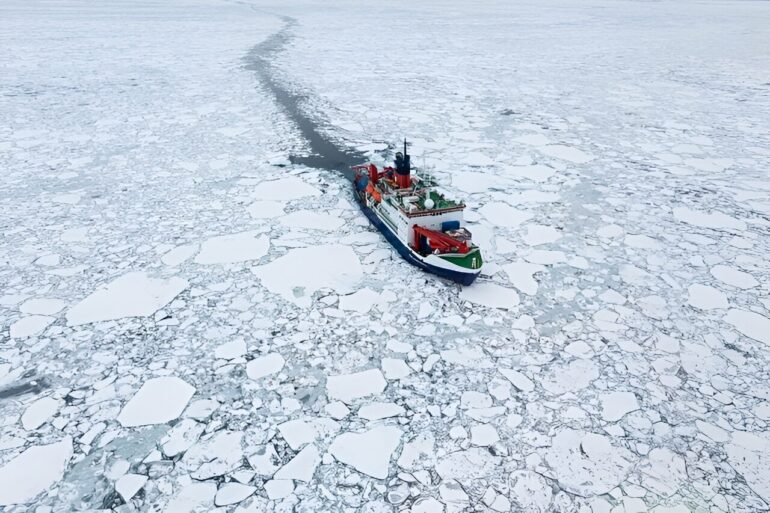Dartmouth researchers are using computational mathematics and machine learning to develop models that better predict sea ice thickness in regions of the Arctic.
“The ice in the Arctic is changing incredibly fast,” says Christopher Polashenski, adjunct associate professor at the Thayer School of Engineering and researcher at the Army Corps of Engineers Cold Regions Research and Engineering Laboratory in Hanover. “I don’t even recognize it from 20 years ago.”
The geophysicist has been conducting fieldwork in the Arctic for almost two decades, measuring the properties of sea ice to better understand how it is changing in a warming world.
Researchers no longer ask whether the Arctic will lose its ice cover, they ask when, says Polashenski. “Sea ice is basically the radiator on top of our planet,” he says. Whichever way the Earth’s climate system is moving, sea ice serves to amplify the change. “And quite a bit of our work is trying to figure out just how quickly this is unfolding,” he says.
Earlier this year, Polashenski traveled to the Arctic to deploy an array of buoys equipped with sensors and instruments to autonomously measure ice thickness, the temperature of the interior of the ice, how much snow is on top of it, and the barometric pressure.
For this project, the team placed 18 buoys across the expanse of the Arctic Ocean. In other instances, they have planted 800 sensors in an area of one square kilometer to capture a nuanced portrait of sea ice on the small scale.
Hidden in the wealth of data that Polashenski and others collect from hard-to-get-to places are answers to a wide range of questions about sea ice—from short-term predictions about whether an icebreaker ship can find its way across without getting stuck or whether it is safe to land a light aircraft to long-term forecasts on what the Arctic and the planet’s climate will look like 50 or 100 years from now.
Mathematicians at Dartmouth are constructing complex computational models to extract answers to such questions.
“It’s one of the most complicated problems that I’ve worked on,” says Anne Gelb, John G. Kemeny Professor of Mathematics. An applied mathematician, Gelb devises computational models and algorithms that can analyze and solve difficult mathematical problems.
Gelb leads the Sea Ice Modeling and Data Assimilation project, a Multidisciplinary University Research Initiative sponsored by the U.S. Department of Defense through the Office of Naval Research. The project brings together mathematicians and engineers from Dartmouth, Arizona State University, and the Massachusetts Institute of Technology, and scientists from CRREL to develop a computational toolkit to improve the quality of predictions using sea ice modeling.
“A common approach to describing physical phenomena is through change, and how quickly one thing changes in relation to another,” says Tongtong Li, a postdoctoral research associate in the Department of Mathematics, who has been a part of the MURI project since 2021.
And change is continual for sea ice. “It’s going somewhere all the time,” says Polashenski. Propelled by winds, ice floes are adrift all winter long, moving somewhere between a tenth of a kilometer to a kilometer an hour, he says.
To model such real-world scenarios, researchers typically numerically simulate partial differential equations that describe how specific variables change both spatially and temporally in relation to each other. The equations are widely used to model a diverse range of complex and dynamic physical and engineering phenomena, such as heat flow in rocket engines and weather forecasting.
For complex phenomena, the equations can get complicated very quickly. Researchers modeling the sea ice, for instance, must consider several variables that change with time and are interrelated—how quickly ice floes move on the water, how their thickness varies, and the concentration of ice in an area. These factors are also influenced by external forces in the environment like wind speed and temperature.
Finding exact solutions that capture the entire physics of the system is impossible in these scenarios. Instead, mathematicians devise numerical methods that can find approximate solutions with the aid of computer programs.
Gelb and her team of mathematicians started with a widely accepted sea ice model that was proposed in the 1970s. “Our expertise lies in using better computational tools to bring the most cutting-edge numerical methods to solve the model,” she says.
Data drawn from measurements in the Arctic and from satellite images serve as checks and balances that verify whether the solutions are reasonable, says Li. When simulations produced by a model don’t match actual observations, it often implies that the model needs to be improved to better capture the physical processes at play, or that its translation into a computer model needs correcting.
“What the ice actually does in the real world is the best guide for whether you got your model right or not. Because I collect the data, I’m the guy with the answer key,” says Polashenski.
What follows are a series of tweaks to the model and improved simulations that maintain physical and mathematical integrity, which the researchers rigorously evaluate to more closely match observations.
Models that mimic reality offer a gateway to understanding sea ice—what it looks like, how it moves, how it fractures when an icebreaker plows through it, how stresses in the ice caused by a storm in one corner of the Arctic can ricochet a thousand kilometers away. They allow researchers to predict changes with time, enabling them to create navigation guides for current travelers or build future climate models.
By using more sophisticated numerical techniques, Li has shown that the accuracy and robustness of a special case of the popular sea ice model can be improved. The researchers are now working to extend this approach to more realistic environments.
The ultimate challenge, the researchers say, is to create a model that can reconcile the behavior of the ice within a small region as well as recreate ice movements across the Arctic. Because the thickness of ice, and some of its other properties, are so variable, this is a formidable undertaking.
Just as data keeps the models accountable and realistic, the models inform data collection.
“The constant shifting of the ice makes it difficult to get measurements,” Polashenski says. Satellite images taken at the same location at different times may be looking at a different ice floe altogether. Models that track how the ice is moving can shift the relative positions of the images, so they stack up correctly.
Computational modeling also reveals current information gaps, creating a guide for future datasets, says Gelb. “I am amazed by what people can collect despite how difficult it is,” she says. So it is vital to understand the limitations of the data and evaluate the payoffs of generating datasets that will make the models more successful at accurately capturing sea ice dynamics.
A new and exciting development is the use of machine learning to create models, Gelb says. “With enough data, we can build algorithms that can learn the partial differential equations that describe the dynamics of the system,” she says.
Physical systems have properties like energy that remain constant—they are conserved—even when changes occur in the system. In a paper appearing in SIAM Journal on Scientific Computing, Gelb and her collaborators show that designing neural networks in a form that obeys mathematical principles of conservation makes a huge difference to the validity of the models they generate.
Gelb, Li, and others are creating fundamental new computational mathematics toolkits that, combined with better data, will be crucial to understand global climate systems and how they are changing, says Polshenski, who foresees Arctic summers that will be completely ice-free within his lifetime.
“It’s one of the largest changes that has ever occurred in human history, to have an area that’s larger than the continental United States and watch it go from ice to not ice,” he says. “That’s a profound change.”
More information:
Zhen Chen et al, Learning the Dynamics for Unknown Hyperbolic Conservation Laws Using Deep Neural Networks, SIAM Journal on Scientific Computing (2024). DOI: 10.1137/22M1537333
Citation:
Mathematicians team up with geophysicists to improve models that predict changes in sea ice (2024, July 18)



